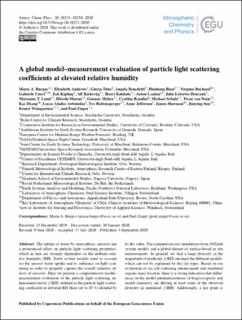| dc.contributor.author | Burgos, María A. | |
| dc.contributor.author | Andrews, Elisabeth | |
| dc.contributor.author | Titos, Gloria | |
| dc.contributor.author | Benedetti, Angela | |
| dc.contributor.author | Bian, Huisheng | |
| dc.contributor.author | Buchard, Virginie | |
| dc.contributor.author | Curci, Gabriele | |
| dc.contributor.author | Kipling, Zak | |
| dc.contributor.author | Kirkevåg, Alf | |
| dc.contributor.author | Kokkola, Harri | |
| dc.contributor.author | Laakso, Anton | |
| dc.contributor.author | Letertre-Danczak, Julie | |
| dc.contributor.author | Lund, Marianne Tronstad | |
| dc.contributor.author | Matsui, Hitoshi | |
| dc.contributor.author | Myhre, Gunnar | |
| dc.contributor.author | Randles, Cynthia | |
| dc.contributor.author | Schulz, Michael | |
| dc.contributor.author | Noije, Twan van | |
| dc.contributor.author | Zhang, Kai | |
| dc.contributor.author | Alados-Arboledas, Lucas | |
| dc.contributor.author | Baltensperger, Urs | |
| dc.contributor.author | Jefferson, Anne | |
| dc.contributor.author | Sherman, James | |
| dc.contributor.author | Sun, Junying | |
| dc.contributor.author | Weingartner, Ernest | |
| dc.contributor.author | Zieger, Paul | |
| dc.date.accessioned | 2021-08-11T11:54:35Z | |
| dc.date.available | 2021-08-11T11:54:35Z | |
| dc.date.created | 2020-09-29T17:56:48Z | |
| dc.date.issued | 2020 | |
| dc.identifier.citation | Atmospheric Chemistry and Physics. 2020, 20 10231-10258. | en_US |
| dc.identifier.issn | 1680-7316 | |
| dc.identifier.uri | https://hdl.handle.net/11250/2767376 | |
| dc.description.abstract | The uptake of water by atmospheric aerosols has a pronounced effect on particle light scattering properties, which in turn are strongly dependent on the ambient relative humidity (RH). Earth system models need to account for the aerosol water uptake and its influence on light scattering in order to properly capture the overall radiative effects of aerosols. Here we present a comprehensive model–measurement evaluation of the particle light scattering enhancement factor f(RH), defined as the particle light scattering coefficient at elevated RH (here set to 85 %) divided by its dry value. The comparison uses simulations from 10 Earth system models and a global dataset of surface-based in situ measurements. In general, we find a large diversity in the magnitude of predicted f(RH) amongst the different models, which can not be explained by the site types. Based on our evaluation of sea salt scattering enhancement and simulated organic mass fraction, there is a strong indication that differences in the model parameterizations of hygroscopicity and model chemistry are driving at least some of the observed diversity in simulated f(RH). Additionally, a key point is that defining dry conditions is difficult from an observational point of view and, depending on the aerosol, may influence the measured f(RH). The definition of dry also impacts our model evaluation, because several models exhibit significant water uptake between RH = 0 % and 40 %. The multisite average ratio between model outputs and measurements is 1.64 when RH = 0 % is assumed as the model dry RH and 1.16 when RH = 40 % is the model dry RH value. The overestimation by the models is believed to originate from the hygroscopicity parameterizations at the lower RH range which may not implement all phenomena taking place (i.e., not fully dried particles and hysteresis effects). This will be particularly relevant when a location is dominated by a deliquescent aerosol such as sea salt. Our results emphasize the need to consider the measurement conditions in such comparisons and recognize that measurements referred to as dry may not be dry in model terms. Recommendations for future model–measurement evaluation and model improvements are provided. | en_US |
| dc.language.iso | eng | en_US |
| dc.publisher | Copernicus publications | en_US |
| dc.rights | Navngivelse 4.0 Internasjonal | * |
| dc.rights.uri | http://creativecommons.org/licenses/by/4.0/deed.no | * |
| dc.title | A global model–measurement evaluation of particle light scattering coefficients at elevated relative humidity, | en_US |
| dc.type | Journal article | en_US |
| dc.type | Peer reviewed | en_US |
| dc.description.version | publishedVersion | en_US |
| dc.source.pagenumber | 10231-10258 | en_US |
| dc.source.volume | 20 | en_US |
| dc.source.journal | Atmospheric Chemistry and Physics | en_US |
| dc.identifier.doi | 10.5194/acp-20-10231-2020 | |
| dc.identifier.cristin | 1835122 | |
| dc.relation.project | Norges forskningsråd: 295046 | en_US |
| dc.relation.project | Notur/NorStore: NS9252K | en_US |
| cristin.ispublished | true | |
| cristin.fulltext | original | |
| cristin.qualitycode | 2 | |

